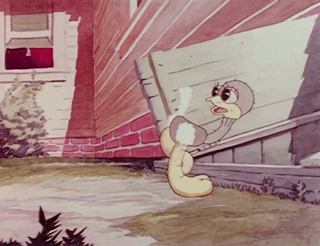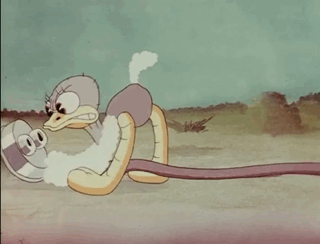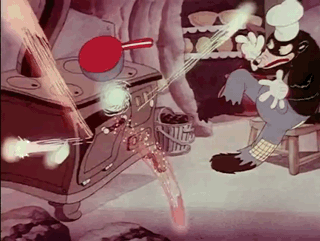Release date: July 31st, 1937
Series: Merrie Melodies
Director: Friz Freleng
Starring: Mel Blanc (Weasel), Bob Clampett (Chicken)
Another “first” to come from this cartoon: this is the first cartoon to debut the ever popular “eat at joe’s” gag, a gag that would bubble up in cartoons for years to come–even being referenced in Space Jam.
This is a music score that frequents many a cartoon, used only a few months before in Friz’s The Fella with the Fiddle. A short that’s more on par with Friz’s cutesy cartoons, the life and times of a baby ostrich are chronicled, including an absolutely explosive encounter with a weasel.
Open to some shots of chickens strutting around on a farm. Inside of the chicken coop, a restless hen sits on her eggs. Her situation is demonstrated quite clearly, the mother-to-be heaving a sigh before crossing off another day on a nearby calendar. Thankfully, her wait is cut short: a plethora of chicks pop right out from beneath the other.
Just as the mother believes her business is done, we hear a thunk beneath her. Mother hen is propelled into the air as a baby ostrich pokes its rather large head out from the nest and stares right at the camera. Treg Brown’s differentiation between the little pops of the chicks hatching and the thud of the ostrich hatching is to be commended, as is Freleng’s musical timing and Carl Stalling’s music score.
Tashlin-esque is the word to describe the camera angle as the startled mother hen dives off of the ostrich’s head and “swallows” the camera with her feathers (much like the “swallow takes” so prevalent in the Harman and Ising days, where a character would run towards the camera with their mouth open and essentially swallow the camera and the audience.)
Mother hen is equally as befuddled as the audience as to why she hatched a baby ostrich. She clucks frantically to her fellow chickens and points back to her nest, summoning the entire barnyard to get a gander at her creation. Even the chicks themselves, who initially dispersed in fear, crowd around the ostrich to get a good look again.
Though it is partly intentional, the timing of the next sequence of the ostrich attempting (and failing) to stand up feels a little bloated. “Cute” and “ostrich” are two words that you don’t find next to each other when describing the ostriches in Looney Tunes (such as Porky’s pet ostrich Lulu in Porky’s Pet a year prior, or even as far as 1962 with the baby ostrich in Bob McKimson’s Mother was a Rooster), and here isn’t much of an exception, but I do applaud the crew for giving the baby some dimension. The animation of the ostrich is very floaty and rubbery, not at all flat. The fascination by the other hens quickly turns to contempt after the baby ostrich sticks its tongue out at the crowd analyzing it with such scrutiny.
Next, more contrasts are established between the hens and the ostrich, alienating the latter even more. Not only is the mother hen and her chicks more confident in their walking than the poor little ostrich, the music stylings also juxtapose with each other. The click of the woodblock as each character takes a step in synchronization calls back to the days of the Norman Spencer scores–there was never a cartoon lacking a woodblock!
As the curious little ostrich marches forward, she spots a hole in a nearby fence, sticking her spindly neck through it. There lies a pond on the opposite side, with a fish swimming in it, ripe for the picking. The ostrich swallows the fish, the pesky fish thrashing around in the ostrich’s mouth. Mother hen must come to the rescue and pull her seemingly stuck child out from the hole in the fence. She succeeds, the ostrich finally spitting out the fish before her head gets sucked out from the hole. Fade out to a very angry mother scolding her clueless ostrich child.
Mother and children, ostrich and all, continue their walk. The baby ostrich comes across an open basement door hatch, accidentally walking right into it. Judging by the smears as realization strikes, I’d wage this as Ken Harris animation.
We then segue into a closeup of the ostrich falling down the basement stairs, once again “swallowing” the camera as it tumbles right towards the audience. While this is seldom the most exciting cartoon, these Tashlin-esque (or, rather Harman and Ising-esque) camera angles do break up the monotony.
Now in the basement, the ostrich wastes no time in finding another food source–this time, a mechanical lever. It swallows the lever whole, stalking away proudly with its chin out. All seems well, until the ostrich bursts into a hiccupping fit (sfx provided by, of course, Mel Blanc), the lever rapidly extending the ostrich’s next with each burst. A few more hiccups and the ostrich is knocked back down a few notches, giving the audience a nonplussed stare. While not the funniest gag on the planet, the sound effects and animation synchronization do add some factors to be appreciative of.
Elsewhere, mother hen places a scoop of dirt in a meat grinder, clucking for her children to come hither. Mother hen squeezes the grinder, prompting a plethora of worms to come out of the holes, chased by a swarm of hungry chicks. One of the worms moves right past the open basement hatch, where the inquisitive little ostrich has its head poking out of.
As to be expected, predator stalks its prey–the lumbering motif of the ostrich mixes quite well with the string chord progressions of the worm inching its way forward. I believe this may be another Ken Harris scene on account of the smears–the ostrich turns its back on the worm, whistling and rocking back and forth on its feet as nonchalantly as possible, avoiding the worm’s scrutinizing gaze.
The spirit of the Harman and Ising days are strong in the following chase sequence as the ostrich runs after its worm prey–reused animation of an animal chasing a worm from countless H-I cartoons comes to mind. This scene, of course, has a higher level of sophistication to it: good music score, sound effects, and rubbery, tactile animation, but the spirit remains the same.
Finally, the worm dives into a hole, conveniently paced near a hose. Inquisitive as always, the ostrich eyeballs the hose, and gets a spurt of water in the eye in return. Thus sparks a brawl between the two as the hose becomes anthropomorphic: the hose squirts water into the ostrich’s eyes (with some wonderful musical timing in the process)–a nice little detail is adding the extra lines to the rings of the hose, creating the illusion of angry eyebrows.
Recognizing the power imbalance, the ostrich buries its head in the ground, prompting the hose to snake in through an adjacent hole and squirt the ostrich once more. Enraged, the ostrich attacks, repeatedly smashing the hose against the ground. I love the detail of the feathers turning into big hands, and the smears as the hose is banged against the ground is another wonderful touch–one that leads me to say this is Ken Harris animation once more.
For a final act of defiance, the ostrich swallows the hose whole. Of course, the hose retaliates, gushing a geyser of water that propels the ostrich backwards, its body swinging in and out of the foreground (in a very similar manner to Egghead on his horse in Egghead Rides Again.) For a final time, the ostrich buries its head in the ground, where it is greeted with trouble.
A hungry weasel (helpfully labeled “the rat!” Tex Avery style) burrowed in the ground has its sights set on the baby ostrich. Ostrich takes notice, and we shoot back to the above ground where we see its body being sucked into the hole. Mother hen makes a rather random appearance, darting over to the hole and clucking around anxiously, mourning her loss.
Thus sparks the highlight of the cartoon: the musical number. The weasel, preparing to cook up a nice, hearty batch of ostrich, wonderfully butchers the title song as “With Plenty of Gravy on You”. Funnily enough, Daffy would reuse the same song and same re-branding of “With Plenty of Gravy on you” in Porky’s Last Stand not even 3 years later. Mel’s pinched, raspy, scratchy vocals as the weasel absolutely make for a delightfully awkward performance. Another fun gag is a closeup of the weasel’s cookbook, which reads:
OSTRICH A LA KING
BY DIZZIE FISH
Take one or two or maybe three or four or five egg–
…or let’s just call the whole thing off and
amble out to a
suey joint.
In the midst of the weasel’s song, the ostrich displays its interest by ingesting a nearby lightbulb, prompting a frustrated weasel to march over to its makeshift coop and pluck the lightbulb out from the ostrich’s throat, all accompanied by a quick, furtive little motif of “Mysterious Mose”.
The weasel heads back to his work, where the ostrich now feasts on a conveniently placed box of fireworks. Ever oblivious to this, the weasel stuffs his dinner-to-be into his garnished pan and stuffs it into the oven.
Synchronization between sound and animation is a strong suit for Freleng, and here is no exception, whether it’s the ostrich panting inside the oven to the brassy beat of the music, or the ostrich projectile vomiting fireworks and causing explosions abound in synchronization to a rampant rendition of the title song. The effects of the fireworks are definitely artsy on their own: lots of glows, little circles, streaks, and so forth.
After a burst of energy, the oblivious ostrich pants, now safe on the ground, where a befuddled weasel cautiously approaches his dinner. He peers into the ostrich’s mouth, prompting another flurry of projectile vomited fireworks, climaxing into the ostrich spitting out bullets, accompanied by a machine gun sound effect. Great, snappy timing in all respects: the animation, the music, the sound effects. Chaotic would be an understatement–it’s a much needed burst of energy in comparison to the sluggish pacing of the beginning portion.
The weasel attempts to dodge the fire, but does so rather unsuccessfully. The impact of it all causes sparks to erupt from the holes in the ground and even starts a tremor in the ground, mother hen and her chicks clinging to corn stalks for safety as the ground rumbles beneath them. Finally, the spectacle ends with a singed and sour weasel dragging the baby ostrich out from a tree and tossing it in front of its mother.
Mother hen reunites with her baby, all previous prejudices thrown out the window. However, mother hen hugs her baby a little too tightly, prompting yet another flurry of fireworks. One firework in particular launches into the sky, exploding to reveal warner bros’ first “Eat at [Sloppy] Joe’s” gag. We therefore iris out on a rather befuddled ostrich.
Though the gags are much faster now than they would be then, this is a Freleng Merrie Melody that feels more like something out of 1935 rather than 1937. That’s not entirely a bad thing–the music score is great, there are some wonderful bits of animation, whether those are Ken Harris’ smears or the dynamic closeups, the sound effects are great, the backgrounds look lovely, and the entire second half with the weasel is the show stealer for certain. Yet the sluggish pace in the first half certainly hinders bits of amusement.
It’s a cute cartoon, but feels like a step back from the nature of the current cartoons in the studio. A certain level of suspended disbelief is required before watching this: how did an ostrich egg get mixed up with the hen’s egg? Why does the weasel randomly store fireworks in his hole? Why is the weasel going after an ostrich and not a chicken? The world may never know. I’m typically pretty good at suspending my disbelief–this is a cartoon, after all–but this certainly has its fair share of head-scratchers.
As I said before, Mel’s performance of the title number is the highlight of the cartoon, as is the whole fireworks spectacle. If anything, I recommend you see the short for those aspects alone. At the very least, give Mel’s song a listen. Other than that, this isn’t a particularly life-changing piece of animation, and I wouldn’t be offended if you didn’t decide to check it out after all.
Nevertheless, link!














No comments:
Post a Comment